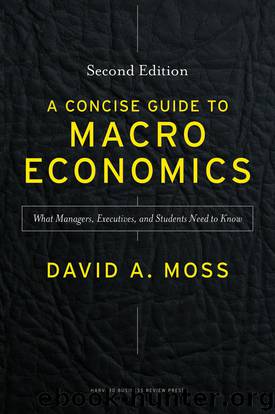A Concise Guide to Macroeconomics, Second Edition: What Managers, Executives, and Students Need to Know by David A. Moss

Author:David A. Moss
Language: eng
Format: mobi
ISBN: 9781625271969
Publisher: Harvard Business Review Press
Published: 2014-07-14T14:00:00+00:00
The Gold Standard: A Self-Regulating Mechanism?
Although many observers today regard a fixed exchange rate as a heavy-handed form of government intervention, it started out as precisely the opposite. Indeed, a fixed exchange rate (against gold and silver) was the least invasive thing the government could do, short of refusing to create any common unit of account or medium of exchange whatsoever.
Even in the absence of a central bank, the fixed exchange rate was supposed to keep the whole economic system in balance—and to do so automatically. If the domestic economy began to overheat and the country experienced inflation (rising prices), imports would increase (because foreign prices would immediately look more attractive than domestic ones) and exports would fall (for the same reason). As the trade balance deteriorated, precious metals would presumably flow out of the country, since it was often assumed that international traders paid for their purchases with gold and silver. Because the domestic money supply was tied directly to these precious metals, it was expected to fall as domestic reserves of precious metals declined. A declining money supply, in turn, would help to rein in prices, thus counteracting the original inflationary surge. Conversely, if prices fell at home and the country experienced deflation, the balance of trade would improve, gold would flow in, the money supply would increase, and prices would be pushed back up to an appropriate level. This, at least, is how the self-adjusting mechanism was supposed to work.
In practice, however, the system did not always come back into balance very rapidly. Tying the dollar rigidly to gold didn't ensure price stability because the quantity of gold—and thus the price of gold—was itself unstable. Through most of the 1880s and 1890s, as the world's gold supply barely inched forward, the overall price level fell in the United States. Since the price of gold was rising (because of its scarcity), the prices of almost everything else (in terms of gold) were falling. Believing that this ongoing deflation was strangling the economy, presidential candidate William Jennings Bryan urged monetary reform in 1896, declaring, “You shall not crucify mankind upon a cross of gold.” Ironically, the world was just then on the verge of a dramatic increase in gold supply. The price level began rising the following year and continued upward for more than a decade.4
By 1913, one of the nation's leading economists, Irving Fisher, was so frustrated with the instability of prices that he proposed a radical reform, which he called “standardizing the dollar.” As gold fell in price relative to other goods, the gold content of the dollar was to be proportionately increased, so that the dollar would remain stable relative to other goods. Conversely, when gold increased in price relative to other goods, he suggested, the gold content of the dollar should be proportionately reduced, again to ensure the stability of the dollar relative to other goods. This way, the dollar would never waver in value, and the overall price level (and thus the cost of living) would be stabilized.
Download
This site does not store any files on its server. We only index and link to content provided by other sites. Please contact the content providers to delete copyright contents if any and email us, we'll remove relevant links or contents immediately.
International Integration of the Brazilian Economy by Elias C. Grivoyannis(74815)
The Radium Girls by Kate Moore(11621)
Turbulence by E. J. Noyes(7700)
Nudge - Improving Decisions about Health, Wealth, and Happiness by Thaler Sunstein(7242)
The Black Swan by Nassim Nicholas Taleb(6764)
Rich Dad Poor Dad by Robert T. Kiyosaki(6175)
Pioneering Portfolio Management by David F. Swensen(6079)
Man-made Catastrophes and Risk Information Concealment by Dmitry Chernov & Didier Sornette(5647)
Zero to One by Peter Thiel(5488)
Secrecy World by Jake Bernstein(4388)
Millionaire: The Philanderer, Gambler, and Duelist Who Invented Modern Finance by Janet Gleeson(4094)
The Age of Surveillance Capitalism by Shoshana Zuboff(3985)
Skin in the Game by Nassim Nicholas Taleb(3965)
The Money Culture by Michael Lewis(3846)
Bullshit Jobs by David Graeber(3830)
Skin in the Game: Hidden Asymmetries in Daily Life by Nassim Nicholas Taleb(3723)
The Dhandho Investor by Mohnish Pabrai(3560)
The Wisdom of Finance by Mihir Desai(3523)
Blockchain Basics by Daniel Drescher(3329)
